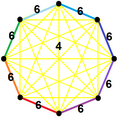| Omnitruncated 7-simplex honeycomb | |
|---|---|
| (No image) | |
| Type | Uniform honeycomb |
| Family | Omnitruncated simplectic honeycomb |
| Schläfli symbol | {3[8]} |
| Coxeter–Dynkin diagrams | |
| 6-face types | t0123456{3,3,3,3,3,3} |
| Vertex figure |  Irr. 7-simplex |
| Symmetry | ×16, [8[3[8]]] |
| Properties | vertex-transitive |
In seven-dimensional Euclidean geometry, the omnitruncated 7-simplex honeycomb is a space-filling tessellation (or honeycomb). It is composed entirely of omnitruncated 7-simplex facets.
Contents
The facets of all omnitruncated simplectic honeycombs are called permutahedra and can be positioned in n+1 space with integral coordinates, permutations of the whole numbers (0,1,..,n).








